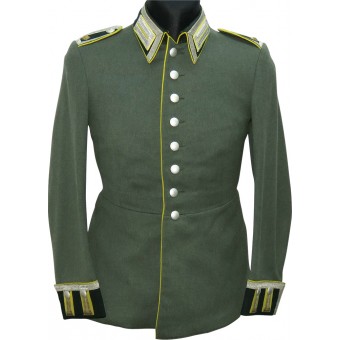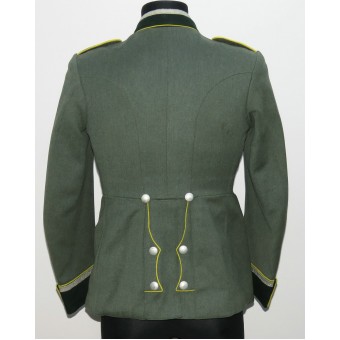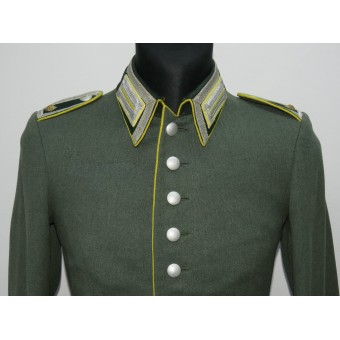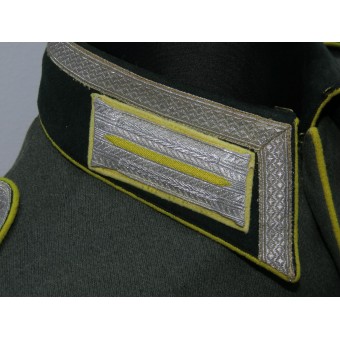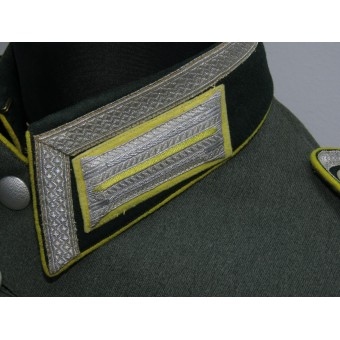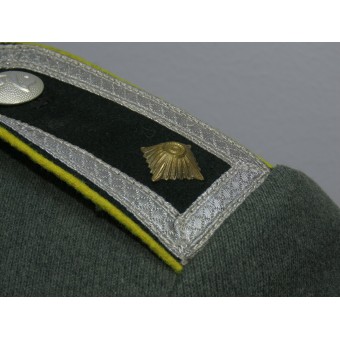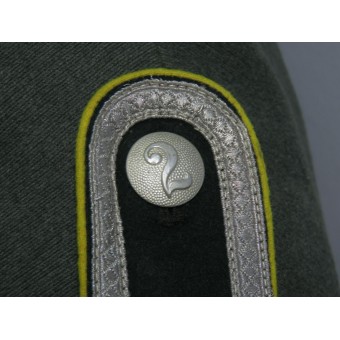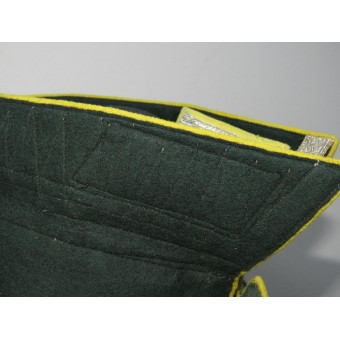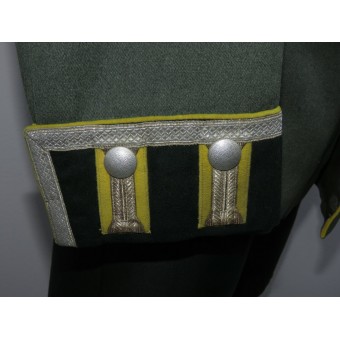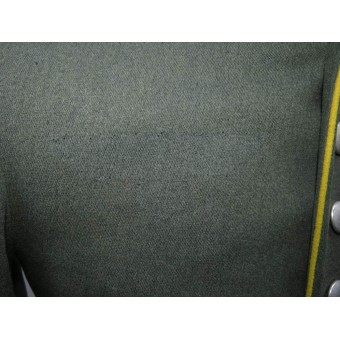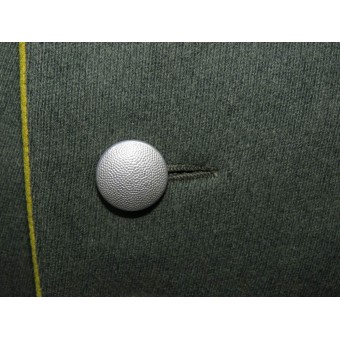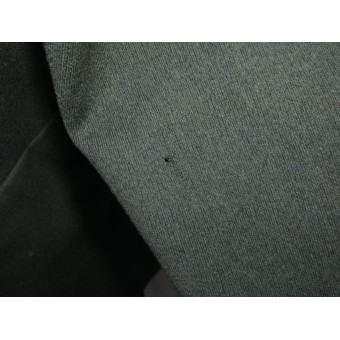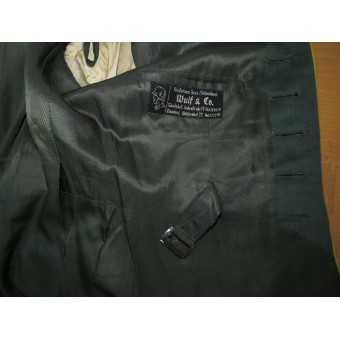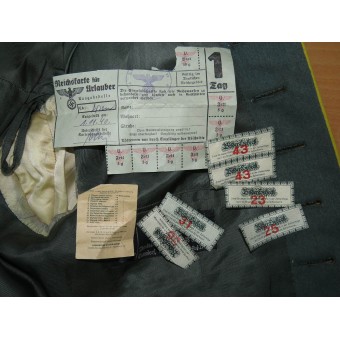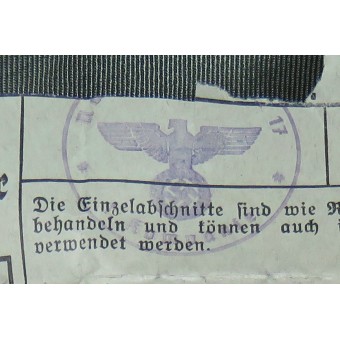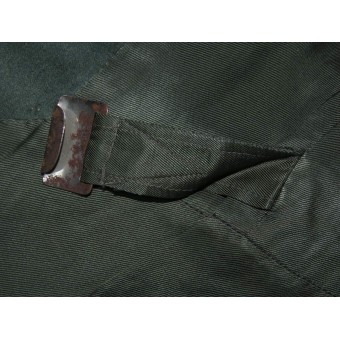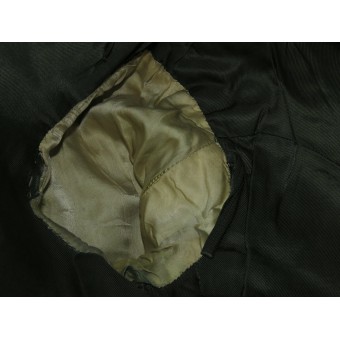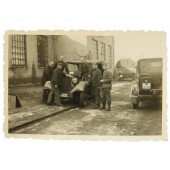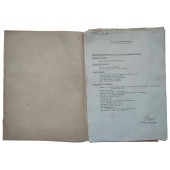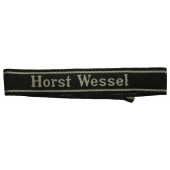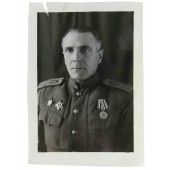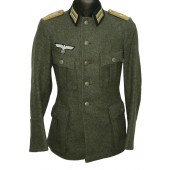A parade/walkout Waffenrock in the rank of Feldwebel of the 17th signals' battalion of the Wehrmacht
A parade/walkout Waffenrock in the rank of Feldwebel of the 17th signals' battalion of the Wehrmacht. Infanterie-Divisions-Nachrichten-Abteilung 17. Custom-tailored tunic by Wulf & Co, as evidenced by the tailor's tag sewn onto the inner pocket: Uniformen Maßschneiderei Wulf & Kompanie Wandsbek, Lindenstraße 18 / Tonndorf 22. The tunic is made of excellent quality officer's wool tricot. Shoulder straps and collar tabs are original to the tunic. The shoulder straps are fastened with buttons with the number 2, indicating that the owner has been served in the second company. There are small traces of insects, but no holes. The breast eagle was removed due to denazification. By new owner wish we can professionally sew correct eagle back for an additional fee. Inside the pocket, were found food cards/tickets dated November 1940, with unit stamp and reference to a unit located in Vienna, Austria. The tunic of approximately size 48 with a breast volume of 95 cm and 85 cm for a waist. Height of approx. 170 cm. The tunic is in excellent condition.
The battalion was created on 6 October 1936 in Schwabach for the 17th Infantry Division of the Wehrmacht. The headquarters of the 17th Infantry Division was formed on October 1, 1934, in Nuremberg, in the VII Military District. Called Infanterieführer VII, which was a camouflage designation for the further expansion of the Reichswehr to the Wehrmacht. On October 15, 1935, the headquarters was renamed the 17th Infantry Division, when secrecy lost its functions. From October 1937, the division was part of the new XIII military district. In the first week of March 1938, the 17th Infantry Division was notified of the possible occupation of Austria. The division was under the control of the XIII Army Corps, and as part of the 2nd wave arrived in Passau, on the Danube, bordering with Austria, on March 12, 1938. The assembly of the division in the Passau area was accompanied by great difficulties due to the fact that the German troops were already in Austria, and various military units of the 1st wave divisions had not yet had time to leave Passau. The XIII Army Corps planned to transfer the division by rail to Linz, but the 8th AK refused. In order to quickly deliver at least parts of the division to Linz, the 12th Infantry Regiment and the III Battalion of the 95th Infantry Regiment, as well as various divisions of the division, were transferred on barges across the Danube to Linz. The first units of the division arrived in Linz on March 13 at 21:00. The bulk of the division, meanwhile, moved overland to Linz. Division headquarters arrived at their designated location in Linz-Urfar on 17 March. The entire division was assembled here. After the annexation of Austria, the division returned to the barracks.
Before the start of the western campaign, the division was transferred to the Oels area and on September 1, 1939, crossed the Polish border. Then the division fought through Boleslawiec, Sieradz, Pabianice to Lodz. In the last days of the Polish campaign, the division took part in the battle at Bzura. In October 1939, the division was transferred to the western border at the Eifel and Hunsrück. From December 1939, the division was in the Trier area. From May 10, the division participated in the French campaign. Subordinate to the XII Army Corps, the division passed through Luxembourg and received its baptism of fire at Longwy. During the second phase of the campaign, "Battle of France", the division moved across Rethel between the Meuse and the Marne in the direction of Bar-le-Duc. On June 18, the division attacked Chamond and moved on through Burgundy towards the demarcation line. The division then remained in France as an occupying force. In May 1941, the division was transferred to Poland to participate in the campaign against the USSR from June 22, 1941. The division advanced north in the Brest-Litovsk area and took part in the battle at Bialystok. The division then moved to Berezina to take part in the Battle of Chernigov, in August and September 1941. From the Bryansk area, the division moved in the direction of Moscow through Kaluga to Serpukhov. The heavy fighting that followed brought the division to Maloyaroslavets and Yukhnov with heavy losses. Here the division remained in heavy defensive battles until May 1942. In June 1942, the division moved to France-Brittany for recovery. In March 1943, the division returned to the Eastern Front and reached Mius north of Taganrog, remaining there until September 1943, when it was forced to retreat to Nikopol. The division remained there until April 1944. The subsequent withdrawal battles brought the 17th Infantry Division to Poland through Chisinau, Iasi, and Varka. In January 1945, the division at the Vistula bridgehead was defeated as a result of a major offensive by the Red Army. The remnants of the division were able to break through to the west.
In March 1945, the division between Hirschberg and Bad Warmbrunn was reorganized from the remainder of the division and through redeployment. Already at the end of March 1945, the division was transferred to Striegau to attack Görlitz. The division, however, was to withdraw to Bautzen via Hirschberg. Here the division surrendered at the end of the war.
A parade/walkout Waffenrock in the rank of Feldwebel of the 17th signals' battalion of the Wehrmacht. Infanterie-Divisions-Nachrichten-Abteilung 17. Custom-tailored tunic by Wulf & Co, as evidenced by the tailor's tag sewn onto the inner pocket: Uniformen Maßschneiderei Wulf & Kompanie Wandsbek, Lindenstraße 18 / Tonndorf 22. The tunic is made of excellent quality officer's wool tricot. Shoulder straps and collar tabs are original to the tunic. The shoulder straps are fastened with buttons with the number 2, indicating that the owner has been served in the second company. There are small traces of insects, but no holes. The breast eagle was removed due to denazification. By new owner wish we can professionally sew correct eagle back for an additional fee. Inside the pocket, were found food cards/tickets dated November 1940, with unit stamp and reference to a unit located in Vienna, Austria. The tunic of approximately size 48 with a breast volume of 95 cm and 85 cm for a waist. Height of approx. 170 cm. The tunic is in excellent condition.
The battalion was created on 6 October 1936 in Schwabach for the 17th Infantry Division of the Wehrmacht. The headquarters of the 17th Infantry Division was formed on October 1, 1934, in Nuremberg, in the VII Military District. Called Infanterieführer VII, which was a camouflage designation for the further expansion of the Reichswehr to the Wehrmacht. On October 15, 1935, the headquarters was renamed the 17th Infantry Division, when secrecy lost its functions. From October 1937, the division was part of the new XIII military district. In the first week of March 1938, the 17th Infantry Division was notified of the possible occupation of Austria. The division was under the control of the XIII Army Corps, and as part of the 2nd wave arrived in Passau, on the Danube, bordering with Austria, on March 12, 1938. The assembly of the division in the Passau area was accompanied by great difficulties due to the fact that the German troops were already in Austria, and various military units of the 1st wave divisions had not yet had time to leave Passau. The XIII Army Corps planned to transfer the division by rail to Linz, but the 8th AK refused. In order to quickly deliver at least parts of the division to Linz, the 12th Infantry Regiment and the III Battalion of the 95th Infantry Regiment, as well as various divisions of the division, were transferred on barges across the Danube to Linz. The first units of the division arrived in Linz on March 13 at 21:00. The bulk of the division, meanwhile, moved overland to Linz. Division headquarters arrived at their designated location in Linz-Urfar on 17 March. The entire division was assembled here. After the annexation of Austria, the division returned to the barracks.
Before the start of the western campaign, the division was transferred to the Oels area and on September 1, 1939, crossed the Polish border. Then the division fought through Boleslawiec, Sieradz, Pabianice to Lodz. In the last days of the Polish campaign, the division took part in the battle at Bzura. In October 1939, the division was transferred to the western border at the Eifel and Hunsrück. From December 1939, the division was in the Trier area. From May 10, the division participated in the French campaign. Subordinate to the XII Army Corps, the division passed through Luxembourg and received its baptism of fire at Longwy. During the second phase of the campaign, "Battle of France", the division moved across Rethel between the Meuse and the Marne in the direction of Bar-le-Duc. On June 18, the division attacked Chamond and moved on through Burgundy towards the demarcation line. The division then remained in France as an occupying force. In May 1941, the division was transferred to Poland to participate in the campaign against the USSR from June 22, 1941. The division advanced north in the Brest-Litovsk area and took part in the battle at Bialystok. The division then moved to Berezina to take part in the Battle of Chernigov, in August and September 1941. From the Bryansk area, the division moved in the direction of Moscow through Kaluga to Serpukhov. The heavy fighting that followed brought the division to Maloyaroslavets and Yukhnov with heavy losses. Here the division remained in heavy defensive battles until May 1942. In June 1942, the division moved to France-Brittany for recovery. In March 1943, the division returned to the Eastern Front and reached Mius north of Taganrog, remaining there until September 1943, when it was forced to retreat to Nikopol. The division remained there until April 1944. The subsequent withdrawal battles brought the 17th Infantry Division to Poland through Chisinau, Iasi, and Varka. In January 1945, the division at the Vistula bridgehead was defeated as a result of a major offensive by the Red Army. The remnants of the division were able to break through to the west.
In March 1945, the division between Hirschberg and Bad Warmbrunn was reorganized from the remainder of the division and through redeployment. Already at the end of March 1945, the division was transferred to Striegau to attack Görlitz. The division, however, was to withdraw to Bautzen via Hirschberg. Here the division surrendered at the end of the war.


